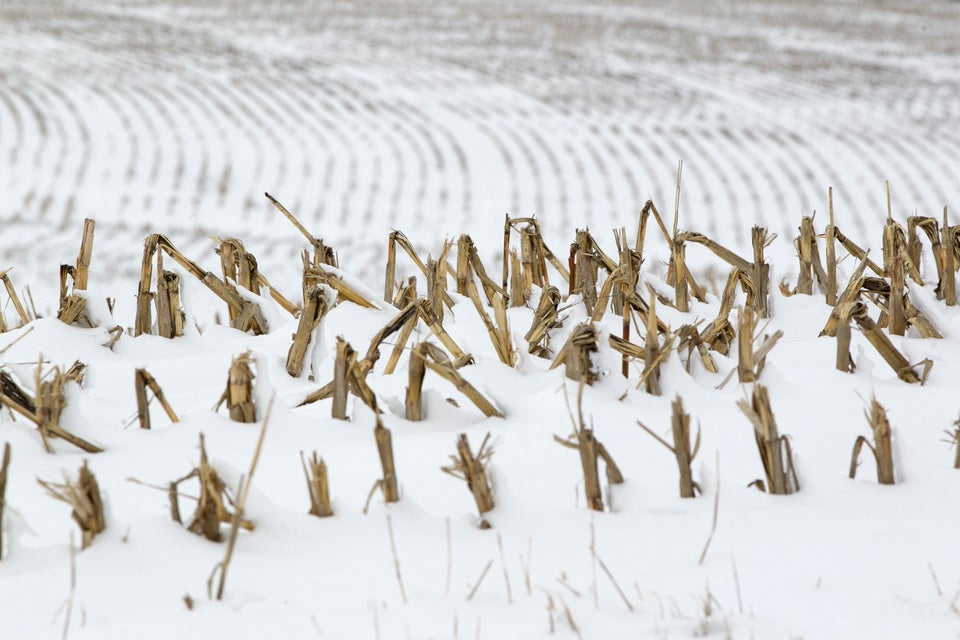* Drought shrivels US corn crop to smallest in 5 years-analysts
* Weather forecasters see chance of some rain next week
* Officials in disaster-hit states promise help
By Ernest Scheyder
July 17 (Reuters) - Broiling heat blanketed much of the U.S. Midwest again on Tuesday, exacerbating the region's worst drought in more than 50 years and devastating corn, soy and other vital crops.
Across the country's agricultural heartland, elected officials met with farmers and ranchers affected by the growing disaster promising government relief.
In Missouri, Governor Jay Nixon announced on Tuesday that all 114 counties in the state have been designated as natural disaster areas due to the drought, making farmers eligible for government loans or other assistance.
Before Tuesday, 17 counties had received disaster status.
In Iowa, Governor Terry Branstad convened a hearing to discuss the drought and its effect on the state's pork industry, which relies heavily on corn feed.
"It's important that we do all we can to help people through this difficult time," Branstad told local radio station KILJ. "And obviously more rain would help."
Although weather forecasters said some parts of the parched region might get some rain next week and help pull corn prices off near-record highs, analysts slashed their forecasts for U.S. corn production by another 7 percent on Tuesday, a Reuters poll found.
From Chicago to St. Louis to Omaha, Nebraska, temperatures eclipsed 100 Fahrenheit (37.8 Celsius) and the National Weather Service issued heat advisories across Midwest and mid-Atlantic states.
Many of the heat advisories don't expire until next week. Temperatures in Kansas City, Kansas, for instance, are expected to hit 104 F (40 C) on Wednesday. In Topeka, the intense heat is drying up soil so far beneath the surface that water lines are cracking.
So far this month, 2,202 heat records have been broken across the United States and another 787 tied, according to the National Climatic Data Center.
Another 14 U.S. cities set new record highs by 8 p.m. EDT (0000 GMT) on Tuesday, according to Accuweather.com, including St. Louis, Milwaukee, Detroit and Syracuse, which all topped out above 100 F.
Those temperatures have contributed to the worst drought since 1956, the National Oceanic and Atmospheric Administration said in a report posted on its website.
FROM CRISIS TO HORROR STORY
About 55 percent of the contiguous United States is in a drought, just as corn plants should be pollinating, a period when adequate moisture is crucial. The United States ships more than half of all world exports of corn, which is made into dozens of products, from starch and ethanol to livestock feed.
"We're moving from a crisis to a horror story," said Purdue University agronomist Tony Vyn. "I see an increasing number of fields that will produce zero grain."
The soonest rain is expected in the Midwest is the middle of next week, said Jason Nicholls, meteorologist for AccuWeather.
The new forecast calls for rains of 0.2 to 0.7 inch (5 mm to 18 mm) around the region, up from earlier outlooks of 0.1 to 0.6 inch.
The dry weather and intense heat likely will continue through August, further damaging the corn crop, AccuWeather said.
Corn prices are at 13-month highs and have surged 45 percent this summer, with analysts expecting the lingering drought to result in the smallest U.S. corn crop in five years.
As the worst drought since the Eisenhower administration begins to expand to the northern and western Midwest, areas that had previously been spared, analysts are slashing corn yield estimates by the hour.
"We need soaking rains now. We need two-to-three-inches and that's not in the forecast," AgResource Co analyst Dan Basse said.
EFFECT ON FOOD PRICES
In April concern mounted that near-record spring corn plantings would sharply increase supply and push corn prices below $5 per bushel.
Now, because of the drought, corn prices are flirting with $8 per bushel, and that could boost food prices.
With much of the Midwest pasture laid waste by the drought and ranchers facing climbing feed costs, many ranchers have begun liquidating their herds, which could translate into higher prices for meat next year.
"Based on my conversations with producers, I would say 75 percent of the corn crop in the heart of the drought is beyond help," said grains analyst Mike Zuzolo, president of Global Commodity Analytics & Consulting in Lafayette, Indiana.
Weather problems were also reported in Eastern Europe and Asia, mirroring drought that dented Argentina and Brazil's last harvest.
Black Sea grain producer Kazakhstan was preparing for a below-average crop this year due to an "alarming" drought in the country's main growing regions.
The United Nations food agency said earlier this month that the U.S. drought was expected to see global food prices snap three months of declines in its July figures.
The drought is even harming equipment makers. Shares of Deere & Co, the world's largest maker of tractors and combines, fell on Tuesday after a JPMorgan analyst said the U.S. drought was likely to harm sales in 2013.

